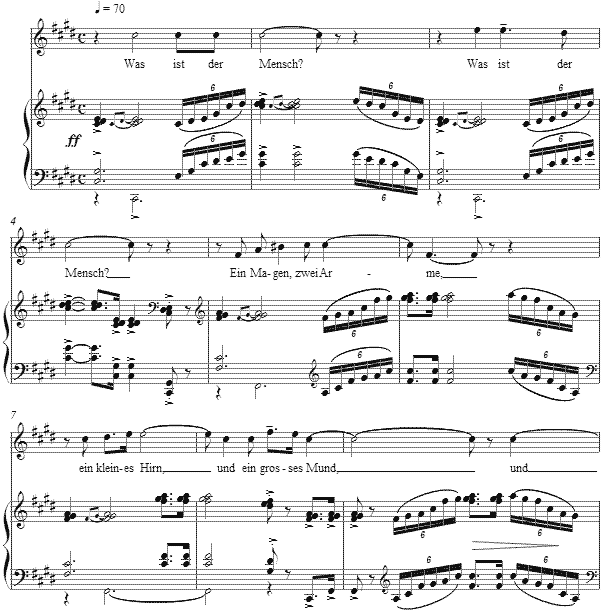Music and Texts of GARY BACHLUND
Vocal Music | Piano | Organ | Chamber Music | Orchestral | Articles and Commentary | Poems and Stories | Miscellany | FAQs
Was ist der Mensch? - (2009)
Erich Kurt Mühsam
for medium or high voice and piano
Was ist der Mensch? Ein Magen, zwei Arme,
ein kleines Hirn und ein großer Mund,
und eine Seele - daß Gott erbarme! -
Was muß der Mensch? Muß schlafen und denken,
muß essen und feilschen und Karren lenken,
muß wuchern mit seinem halben Pfund.
Muß beten und lieben und fluchen und hassen,
muß hoffen und muß sein Glück verpassen -
und leiden wie ein geschundner Hund.[ 4 pages, circa 3' 35" ]
Erich Kurt Mühsam
What is a man? A stomach, two arms,
A little brain and a big mouth,
And a soul -- God help him!
What must a man do? Sleep and think,
Eat and haggle and pull a cart,
Profiteer with his half a pound.
Pray and love and curse and hate,
Hope and take a chance in life --
And suffer like a caged dog.
gb
The text is taken from Wüste - Krater - Wolken. Die Gedichte. Berlin: Paul Cassirer 1914. In this time Germany was in the throes of a growing fatalism, alongside the outbreak in that year of war. Political movements were afoot such as the Social Democrats' growth in strength within the German government of Kaiser Wilhelm II and his chancellor, Theobald von Bethmann Hollweg, whose encouragement of Vienna against Serbia exacerbated social tensions throughout Europe. For more on Mühsam's place in this time, see my setting of his text, Gesang der jungen Anarchisten.
The setting opens in a forte C sharp minor, but after a four-measure stance in the tonic, shifts to the subdominant minor for most of the remainder of the first musical verse, with but a single measure on the dominant to return the setting to C sharp. Therefore the most of the setting lies on F sharp minor. The vocal tone is at first declamatory in asking the question, and thereafter becomes more lyrical in proposing a range of descriptive answers. The augmented seconds which appear in various scalar passages echo the Ashkenazic tradition which was in parallel with German society at that time, decades before the Holocaust of WWII snuffed out much of German Jewish tradition.
The more cantabile answers to Mühsam's rhetorical questions is accompanied by a harmonically static subdominant, which because of its length begins to feel as if the tonic of the setting which it is not. A short dominant fulcrum back to C sharp minor begins the second repetition of the musical form, with an instrumental coda of the cantabile material finally in the tonic minor, its only lengthy appearance.
The score for Was ist der Mensch? is available as a free PDF download, though any major commercial performance or recording of the work is prohibited without prior arrangement with the composer. Click on the graphic below for this piano-vocal score.


